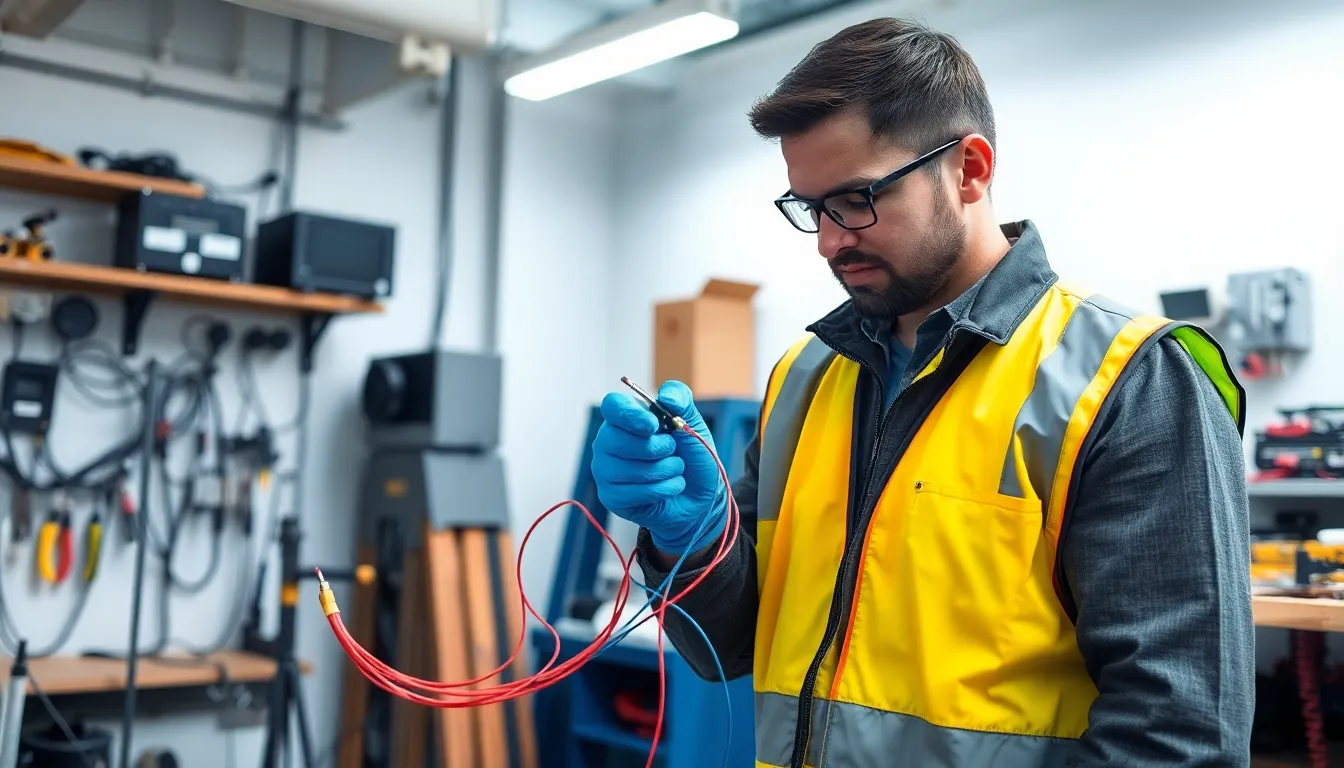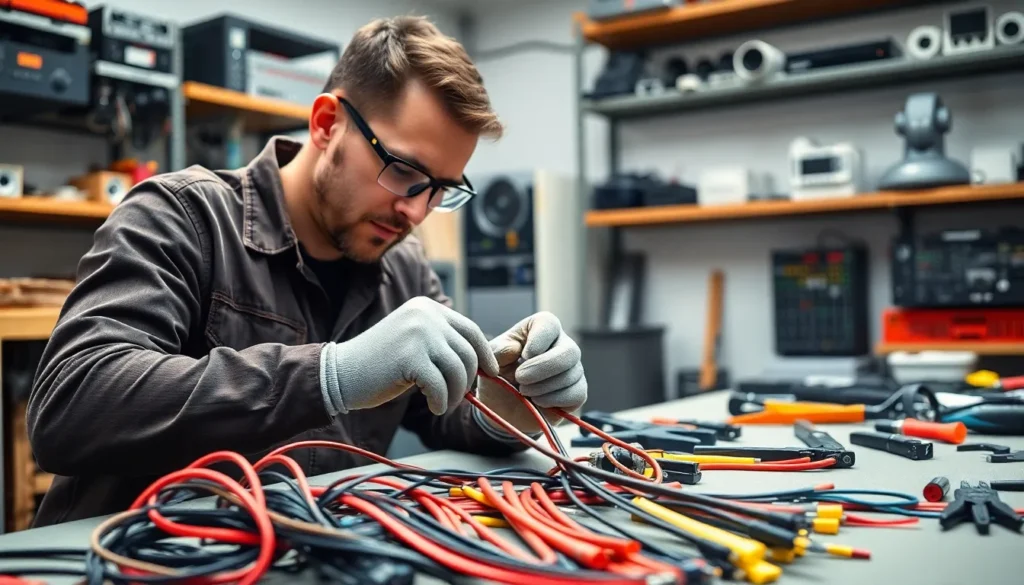Table of Contents
ToggleWhen it comes to splicing security camera wires, understanding color codes isn’t just a nice-to-have; it’s a must-have for keeping your home safe. Imagine trying to connect wires without knowing which color goes where—it’s like playing Twister with your electrical system. One wrong move and you could end up with a camera that’s more decorative than functional.
Overview of Security Camera Wiring
Understanding security camera wiring requires familiarity with various components and their functions. Different types of security cameras, such as analog and digital, may utilize distinct wiring systems. Common wire types include coaxial cables, Ethernet cables, and power cables. Each wire plays a specific role: coaxial cables transmit video signals, Ethernet cables provide data and power via Power over Ethernet (PoE), and power cables supply the necessary electricity.
Color codes serve an essential role in wiring structure. Standardized colors exist for different purposes. For instance, in a typical security camera setup, the red wire often indicates positive power, while the black wire signifies the negative connection. Recognizing these colors enhances the ease of splicing wires and troubleshooting connection issues.
Proper installation hinges on adhering to these color codes. One wrong connection could lead to system malfunctions or even damage. Therefore, verifying connections and ensuring accuracy during splicing is crucial. Visual aids, like wiring diagrams, can simplify the understanding of configurations.
Familiarity with the wire gauge is equally important. The gauge determines the wire’s ability to transmit power without overheating. For example, a 20-gauge wire is more suitable for short distances, whereas a 16-gauge wire is better for longer runs.
Regular maintenance should include inspecting connections for wear and tear. Over time, exposure to environmental elements can degrade wires or connectors, affecting overall performance. Keeping wires secured and organized also minimizes risks of accidental disconnections.
Effective security camera wiring relies on understanding wire types, color codes, and installation practices. This knowledge enhances the reliability and functionality of home security systems.
Importance of Color Coding

Color coding plays a vital role in splicing security camera wires. It aids in identifying connections easily, which enhances the overall functionality and safety of security systems.
Benefits of Proper Color Coding
Proper color coding simplifies installation. Technicians can quickly recognize wire functions, which minimizes error chances. Standard colors enhance efficiency during troubleshooting, allowing for rapid identification of faulty connections. It also reduces the learning curve for new technicians. Familiarizing oneself with standardized colors fosters confidence and speed in installations. This organized approach ultimately contributes to a more reliable security system and supports long-term performance.
Risks of Incorrect Wiring
Incorrect wiring poses significant risks. Misconnections can cause security cameras to malfunction or fail completely. Negative impacts include potential damage to the camera and the security system. Additionally, incorrect wiring may create safety hazards like electrical shorts or fires. It can also lead to costly repairs and replacements, impacting overall system reliability. Without proper color coding, the possibility of confusion increases, resulting in delays and safety issues. Accuracy during installations is crucial to avoid these risks.
Tools Required for Splicing
Understanding necessary tools enhances splicing security camera wires. Using the right equipment ensures efficiency and safety throughout the process.
Essential Tools List
- Wire Stripper: Efficiently removes insulation from wires, exposing bare copper for connections.
- Crimping Tool: Creates secure connections by crimping connectors onto wires, ensuring stability.
- Soldering Iron: Joins wires securely through soldering, creating a reliable electrical connection.
- Heat Shrink Tubing: Protects splices by insulating connections, preventing moisture and wear.
- Cable Ties: Organizes wires neatly, ensuring a tidy installation and reducing clutter.
Safety Equipment
- Safety Glasses: Protect eyes from flying debris when working with wires and tools.
- Gloves: Provide hand protection against sharp wire ends and electrical hazards.
- Voltage Tester: Confirms power is off before starting, preventing electrical shocks during splicing.
- First Aid Kit: Available for quick response to minor injuries that may occur while working.
- Fire Extinguisher: Essential for addressing potential fire hazards arising from electrical work.
Steps to Color Code Splicing Security Camera Wires
Understanding the correct wire colors and splicing techniques ensures effective security camera installations. The following sections detail how to identify wire colors and implement proper splicing techniques.
Identifying Wire Colors
Starting with identification, common wire colors include red for positive power and black for negative connections. Additional colors like yellow, green, and blue may appear, especially in multi-conductor cables. Each color typically represents specific functions within the system, such as video signal transmission or data transfer. Inspecting the camera’s wiring diagram helps clarify these roles. Knowing how to reference this diagram ensures accuracy during connection, preventing errors. Familiarity with these color codes allows technicians to quickly and confidently navigate wiring tasks, bolstering overall installation efficiency.
Proper Splicing Techniques
Implementing proper splicing techniques directly impacts the performance and safety of security systems. Stripping a quarter inch of insulation from the ends of the wires creates space for connections. Next, twisting wire strands together ensures strong and secure bonds. Afterward, utilizing either crimp connectors or soldering enhances the reliability of the splice. Heat shrink tubing may then cover exposed connections, protecting against moisture and debris. Prioritizing these techniques decreases the likelihood of malfunctions while extending the lifespan of the installation. Regular inspections of connections help maintain system integrity and performance.
Common Mistakes to Avoid
Overlooking color codes leads to confusion during installation. Many technicians fail to consult the camera’s wiring diagram, resulting in incorrect connections. Missing the right wire gauge can cause overheating and power transmission issues. Splicing wires without stripping insulation properly risks poor connectivity and malfunctions.
Neglecting to secure connections with crimp connectors or solder increases the likelihood of disconnections. Inadequately protecting exposed connections with heat shrink tubing exposes wires to moisture and debris. Ignoring the need for proper tools, such as wire strippers and crimping tools, complicates the installation process.
Forgetting to conduct regular maintenance can allow wear and tear to go unchecked. Skipping voltage testing before connecting wires leads to potential safety hazards. Assuming all wire colors follow standard coding patterns can result in critical errors.
Rushing the splicing process often results in steps being missed, undermining system integrity. Mislabeling wires during the identification process can cause confusion later. Failing to organize wires using cable ties may lead to tangling and troubleshooting difficulties.
Mastering the art of color code splicing for security camera wires is vital for anyone looking to ensure a reliable home security system. By understanding wire colors and their functions, technicians can avoid costly mistakes that compromise system integrity. Proper installation techniques and the right tools not only enhance safety but also streamline the wiring process.
Regular maintenance and attention to detail further contribute to long-term performance. As technology evolves, staying informed about wiring standards and best practices will empower technicians to deliver effective solutions. Emphasizing accuracy and thoroughness during installations will ultimately lead to a robust security setup that keeps homes safe and secure.




